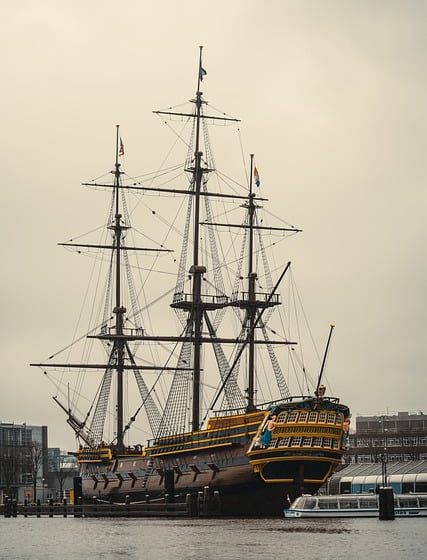The Anatomy of a Ship Exploring the Key Parts and Their Functions
- Business
 stevenbrown
stevenbrown- November 15, 2024
- 3

Ships have been a cornerstone of human exploration, trade, and transportation for centuries. Whether you’re an avid sailor, a maritime enthusiast, or someone simply curious about ships, understanding the various parts of a ship is key to appreciating the complexity and functionality of these remarkable vessels. In this post, we’ll take a deep dive into the major components that make up a modern ship.
1. Hull – The Ship’s Body
The hull is the main body of the ship, and it provides the structure that holds everything together. It is responsible for keeping the vessel afloat and protecting its contents. The hull is usually divided into two sections:
- Keel: The keel is the ship’s backbone, running along the bottom from bow to stern. It provides structural integrity and helps keep the vessel stable.
- Plating: The outer surface of the hull, often made of steel or aluminum, acts as a protective layer against the water and environmental conditions.
Types of Hulls
- Displacement Hull: Found on ships that move at slower speeds and “displace” water as they go. This is common for cargo ships, tankers, and large ocean liners.
- Planing Hull: Common on smaller, faster boats. These hulls “plane” on the water’s surface rather than displacing water, making them more fuel-efficient at high speeds.
2. Deck – The Ship’s Floor
The deck is essentially the floor of the ship and serves as the main surface where crew members and passengers walk. It’s often divided into multiple levels or “decks,” each serving a specific function. The main deck is the uppermost level, and other decks might include:
- Upper Deck: The next level above the main deck, often used for navigation and observation.
- Cargo Deck: For storing cargo in commercial ships, usually located below the main deck.
- Bridge Deck: The area housing the ship’s bridge, which is the command center for navigation and ship operations.
The term “deck” can also refer to any flat surface within the ship, including sections like the aft deck (near the back) and bow deck (at the front).
3. Bow – The Front of the Ship
The bow is the front portion of the ship. It’s the part that cuts through the water as the ship moves forward, and it’s often pointed to reduce water resistance. In addition to its hydrodynamic role, the bow also holds some key features:
- Bow Thruster: A propeller mounted at the bow to aid in maneuvering, especially when docking or navigating tight spaces.
- Stem: The forwardmost part of the hull that leads to the keel.
4. Stern – The Rear of the Ship
The stern is the back section of the ship. This part is crucial for propulsion and direction. Key components at the stern include:
- Rudder: A movable surface used to steer the ship. Located at the stern, the rudder controls the direction of the ship by diverting the water flow.
- Propeller: Located at or near the stern, this is the device that drives the ship forward or backward. Most modern ships use a rotating screw propeller powered by engines to generate thrust.
- Transom: The flat section at the very back of the ship, which can house additional components like the ship’s rudder or a stern ramp on certain vessels.
5. Bridge – The Command Center
The bridge is where the ship is navigated and operated. Located on the uppermost deck or in a tower-like structure, it’s the “command center” of the vessel. It houses:
- Steering Wheel (Helm): The device used by the ship’s captain or officer to control the rudder and steer the vessel.
- Navigation Equipment: Includes radar, GPS, and sonar systems, which help the crew monitor the ship’s position and surroundings, ensuring safe travel.
- Engine Controls: The systems that allow the crew to manage the ship’s propulsion, including throttle and gear controls.
6. Mast – The Ship’s Vertical Structure (Primarily on Sailing Vessels)
For sailing ships, the mast is a vertical structure that supports the sails. Modern ships, particularly those with engines, may not use masts, but they are still a defining feature of traditional sailing ships.
- Mainmast: The tallest and most central mast on the ship, often carrying the largest sail.
- Boom: A horizontal spar that extends from the mast to hold the bottom of the sail.
In modern times, some vessels might still feature masts for carrying antennae or rigging.
7. Bow and Stern Lines – The Ship’s Ropes
When docking, a ship uses ropes or lines to secure it to the dock. These are:
- Bow Line: A rope tied to the ship’s bow, used to prevent the ship from moving forward or drifting.
- Stern Line: A rope tied to the ship’s stern, used to prevent the ship from moving backward.
Together, these lines help keep the vessel stable when it’s at port.
8. Cargo Hold – The Storage Area
On commercial ships, the cargo hold is where goods and materials are stored during transport. The size and number of cargo holds vary depending on the type of ship (container ships, tankers, bulk carriers, etc.). Cargo holds are designed to maximize space and keep goods secure during the journey. Some ships also have refrigerated cargo holds for transporting perishable goods.
9. Engine Room – The Heart of the Ship
The engine room is where the ship’s main engines and machinery are housed. This space is typically below the waterline and is vital for propulsion, electrical systems, and auxiliary functions. It contains:
- Main Engines: The primary power source for moving the ship.
- Auxiliary Engines: Smaller engines used for electrical generation and backup power.
- Boilers: In older ships or larger vessels, boilers generate steam to drive turbines for propulsion.
10. Galley – The Ship’s Kitchen
The galley is the kitchen area on the ship, where food is prepared for the crew and passengers. In large passenger ships, the galley can be quite elaborate, with specialized areas for baking, food storage, and even fine dining. In commercial ships, the galley is often smaller, but it still plays a critical role in providing meals for the crew.
11. Bow and Stern Compartments – Stability and Ballast
To maintain stability, especially in rough seas, ships often contain ballast tanks in the bow and stern areas. These compartments hold water or other materials to help balance the ship and keep it upright.
Conclusion
The anatomy of a ship is a perfect blend of art and engineering. Each part, from the hull to the mast, serves a specific purpose in ensuring the ship functions smoothly and efficiently. Whether it’s the power of the engines driving the ship forward, the stability of the hull keeping it afloat, or the bridge serving as the nerve center of operations, every component plays a crucial role in making a ship more than just a floating structure.
Understanding these parts helps us appreciate the complexity of ship design and how much thought goes into creating a vessel that can navigate the vast oceans of the world safely and effectively.
Have a favorite part of a ship that you’d like to learn more about? Or maybe a specific ship you’d like to know about? Leave a comment below!
